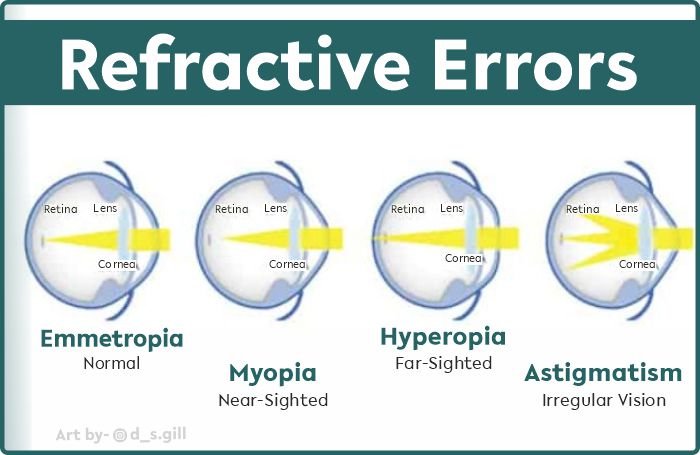Common Vision Problems
Understanding Common Refractive Errors including Myopia, Hyperopia& Astigmatism
Vision is an integral part of our daily lives because it lets us see what’s going on around us. However, a lot of people have refractive flaws that make it hard for them to see clearly. When the shape of the eye stops light from focusing straight on the retina, this is called a refractive error. This piece talks about myopia, hyperopia, and astigmatism, which are three common refractive errors. It looks at their causes, symptoms, and treatments.

Myopia vision disorder
Myopia, popularly known as near-sightedness, is a refractive error where close objects appear clear while distant objects appear blurry. This happens when the eyeball is too long or the cornea is excessively curved, forcing light to focus in front of the retina rather than on it. This impairs the patient’s ability to see well.
Symptoms of Myopia
- Difficulty seeing distant objects clearly.
- Squinting to see far away.
- Eye strain or headaches after prolonged distance vision tasks.
Symptoms of Myopia
- Prescription eyeglasses or contact lenses with concave lenses to help focus light correctly on the retina.
- Refractive surgery, such as LASIK or PRK, to reshape the corneal curvature&fix the refractive error.
Hyperopia vision disorder
Hyperopia is a refractive mistake called farsightedness makes things farther away look clearer than things closer. When this happens, light focuses behind the retina because the lens is too short or the cornea is curved too slightly.
Symptomsof Hyperopia
- Difficulty focusing on close objects.
- Reading or other near tasks leading to Eye strain or headaches.
- Blurred Vision at close range.
Treatment of Hyperopia
- Prescription eyeglasses or contact lenses with convex lenses to bring the focus forward onto the retina.
- Refractive surgery is an option to reshape the cornea and correct hyperopia.
Astigmatism Vision problem
Astigmatism is a common refractive error produced by an irregular shape of the cornea or eye lens, which results in distorted or blurry vision at all distances. Unlike myopia and hyperopia, astigmatism affects both near and far Vision.
Symptoms of Astigmatism
- Blurred or distorted Vision
- Eye strain
- Headaches
Treatment of Astigmatism
- Prescription eyeglasses or contact lenses with cylindrical lenses to correct the irregularities in the cornea or lens.
- Refractive surgery, like LASIK, can also be used to reshape the cornea and correct astigmatism.
Tips for Prevention of Common Vision Disorders
- Schedule regular eye examinations with an optometrist or ophthalmologist to detect refractive errors early and ensure optimal eye health.
- Ensure adequate lighting when reading or performing close tasks to reduce eye strain.
- Follow the 20-20-20 advisory: This suggests that after every 20 minutes of eye exposure to screens, look at something 20 feet away for at least 20 seconds to reduce potential eye strain caused by prolonged screen use.
Conclusion
Myopia, hyperopia, and astigmatism are three prevalent types of refractive abnormalities that are discussed in this article. Insight is provided into their respective causes, symptoms, and potential treatments. Remember, Vision is an essential component of our day-to-day lives because it enables us to understand the world that is all around us. Despite this, a significant number of people suffer from refractive errors, which can diminish the sharpness of their Vision. Eyes with refractive faults have a shape that inhibits light from focusing directly on the retina, which can lead to vision problems. Global Eye Hospital Patiala has a Refractive Vision Problems center that provides modern treatments at affordable costs for all patients interested in living an eyeglass-free life or reducing their dependence on spectacles.
